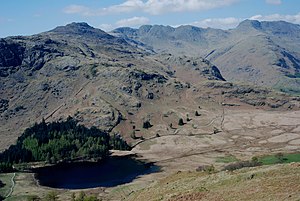Difference between revisions of "Blea Tarn"
| Line 5: | Line 5: | ||
The tarn itself was shaped anciently by glacial ice moving over the col from nearby Great Langdale, but the ice was cut off as the glacier shrank, leaving "moraines very different from those at the head of the main valley".<ref>The Tarns of Lakeland, vol. 1, Anne Nuttall, Cicerone Press, 1995, p. 163</ref> A carpark for twenty vehicles is sited close to the tarn with an all-ability trail leading around the tarn.<ref>{{NT link|Little Langdale}}</ref> | The tarn itself was shaped anciently by glacial ice moving over the col from nearby Great Langdale, but the ice was cut off as the glacier shrank, leaving "moraines very different from those at the head of the main valley".<ref>The Tarns of Lakeland, vol. 1, Anne Nuttall, Cicerone Press, 1995, p. 163</ref> A carpark for twenty vehicles is sited close to the tarn with an all-ability trail leading around the tarn.<ref>{{NT link|Little Langdale}}</ref> | ||
| − | The tarn is forested on its western shore with rhododendrons also found there, the other shores being grassland. Blea Tarn was characterised in 1969 as being low in nutrients and acidic but not having suffered from fertiliser pollution. | + | The tarn is forested on its western shore with rhododendrons also found there, the other shores being grassland. Blea Tarn was characterised in 1969 as being low in nutrients and acidic but not having suffered from fertiliser pollution. Brown trout, perch and pike can all be found in the tarn. |
Blea Tarn was designated a 'site of special scientific interest' in 1989 because of its importance for palaeo-environmental studies relating to the Devensian and Flandrian times.<ref>{{sssi|1000814|Blea Tarn}}</ref><ref>{{cite web |url=http://www.windermere-lakes.co.uk/uploader/pdf/Windermere%20Fluvial%20Audit%20-%20Report%20A%20Final.pdf |title=Report A - Catchment Scale Geomorphology - Technical Report |author=Jacobs Engineering UK Limited |date=February 2009 |work=Windermere Fluvial Audit |publisher=|accessdate=13 February 2011}} p13</ref> Pollen analysis from Blea Tarn shows evidence for elm branches being collected as fodder from 3300 BC and forest clearances occurring from around 3000 to 2000 BC, corresponding with the dates of the Langdale axe industry in the Neolithic Age.<ref>{{cite book |url=http://books.google.com/books?id=uBg9AAAAIAAJ&pg=PA69&lpg=PA69&dq=blea+tarn+langdale+elm+clearance&source=bl&ots=4OAkRTm5KK&sig=wxnQhoRFzUNGUmTaXi5J4JzNvmU&hl=en&ei=OE1PTcOqJcyIhQfd4sGsDg&sa=X&oi=book_result&ct=result&resnum=1&ved=0CBIQ6AEwAA#v=onepage&q=blea%20tarn%20langdale%20elm%20clearance&f=false |title=Studies in the Vegetational History of the British Isles |author=|date=|work=|publisher=CUP Archive |accessdate=13 February 2011 |pages=69–74}}</ref> | Blea Tarn was designated a 'site of special scientific interest' in 1989 because of its importance for palaeo-environmental studies relating to the Devensian and Flandrian times.<ref>{{sssi|1000814|Blea Tarn}}</ref><ref>{{cite web |url=http://www.windermere-lakes.co.uk/uploader/pdf/Windermere%20Fluvial%20Audit%20-%20Report%20A%20Final.pdf |title=Report A - Catchment Scale Geomorphology - Technical Report |author=Jacobs Engineering UK Limited |date=February 2009 |work=Windermere Fluvial Audit |publisher=|accessdate=13 February 2011}} p13</ref> Pollen analysis from Blea Tarn shows evidence for elm branches being collected as fodder from 3300 BC and forest clearances occurring from around 3000 to 2000 BC, corresponding with the dates of the Langdale axe industry in the Neolithic Age.<ref>{{cite book |url=http://books.google.com/books?id=uBg9AAAAIAAJ&pg=PA69&lpg=PA69&dq=blea+tarn+langdale+elm+clearance&source=bl&ots=4OAkRTm5KK&sig=wxnQhoRFzUNGUmTaXi5J4JzNvmU&hl=en&ei=OE1PTcOqJcyIhQfd4sGsDg&sa=X&oi=book_result&ct=result&resnum=1&ved=0CBIQ6AEwAA#v=onepage&q=blea%20tarn%20langdale%20elm%20clearance&f=false |title=Studies in the Vegetational History of the British Isles |author=|date=|work=|publisher=CUP Archive |accessdate=13 February 2011 |pages=69–74}}</ref> | ||
Latest revision as of 23:35, 22 January 2016
Blea Tarn in lies in a small hanging valley between Great Langdale and Little Langdale in Westmorland.
The tarn itself was shaped anciently by glacial ice moving over the col from nearby Great Langdale, but the ice was cut off as the glacier shrank, leaving "moraines very different from those at the head of the main valley".[1] A carpark for twenty vehicles is sited close to the tarn with an all-ability trail leading around the tarn.[2]
The tarn is forested on its western shore with rhododendrons also found there, the other shores being grassland. Blea Tarn was characterised in 1969 as being low in nutrients and acidic but not having suffered from fertiliser pollution. Brown trout, perch and pike can all be found in the tarn.
Blea Tarn was designated a 'site of special scientific interest' in 1989 because of its importance for palaeo-environmental studies relating to the Devensian and Flandrian times.[3][4] Pollen analysis from Blea Tarn shows evidence for elm branches being collected as fodder from 3300 BC and forest clearances occurring from around 3000 to 2000 BC, corresponding with the dates of the Langdale axe industry in the Neolithic Age.[5]
The nearby Side Pike SSSI was designated in 1977 as one of the few areas in the British Isles where rock demonstrating subaerial volcanic processes are seen. The ignimbrite and tuff rocks there form part of the Borrowdale Volcanic Group.[6]
Outside links
| ("Wikimedia Commons" has material about Blea Tarn) |
- Location map: 54.43028 -3.09111
References
- ↑ The Tarns of Lakeland, vol. 1, Anne Nuttall, Cicerone Press, 1995, p. 163
- ↑ Little Langdale
- ↑ SSSI listing and designation for Blea Tarn
- ↑ Jacobs Engineering UK Limited (February 2009). "Report A - Catchment Scale Geomorphology - Technical Report". Windermere Fluvial Audit. http://www.windermere-lakes.co.uk/uploader/pdf/Windermere%20Fluvial%20Audit%20-%20Report%20A%20Final.pdf. Retrieved 13 February 2011. p13
- ↑ Studies in the Vegetational History of the British Isles. CUP Archive. pp. 69–74. http://books.google.com/books?id=uBg9AAAAIAAJ&pg=PA69&lpg=PA69&dq=blea+tarn+langdale+elm+clearance&source=bl&ots=4OAkRTm5KK&sig=wxnQhoRFzUNGUmTaXi5J4JzNvmU&hl=en&ei=OE1PTcOqJcyIhQfd4sGsDg&sa=X&oi=book_result&ct=result&resnum=1&ved=0CBIQ6AEwAA#v=onepage&q=blea%20tarn%20langdale%20elm%20clearance&f=false. Retrieved 13 February 2011.
- ↑ SSSI listing and designation for Side Pike
